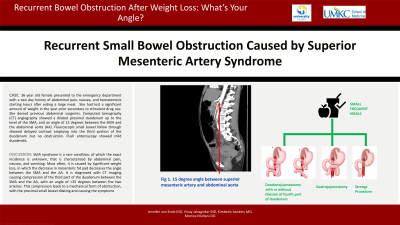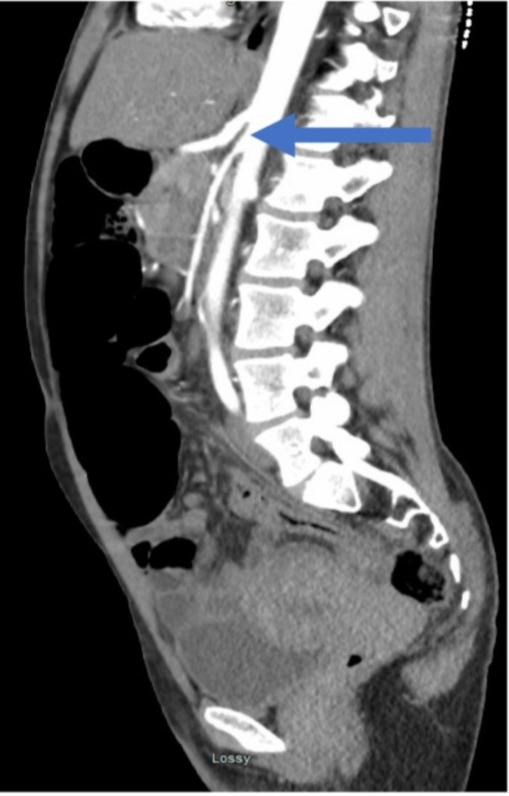Sunday Poster Session
Category: Small Intestine
P1289 - Recurrent Bowel Obstruction After Weight Loss: What’s Your Angle?
Sunday, October 22, 2023
3:30 PM - 7:00 PM PT
Location: Exhibit Hall

Has Audio
- Jv
Jennifer von Ende, MD
University of Missouri Kansas City
Kansas City, MO
Presenting Author(s)
Jennifer von Ende, MD1, Vinay Jahagirdar, MD2, Kimberly Sanders, MD1, Monica Multani, DO3
1University of Missouri Kansas City, Kansas City, MO; 2University of Missouri-Kansas City, Kansas City, MO; 3Saint Lukes Hospital, Kansas City, MO
Introduction: Small bowel obstructions (SBO) are a relatively common cause of hospitalization, with over 350,000 cases annually in the United States. The most common causes of SBO include intraabdominal adhesions, hernias, intraluminal obstruction, and inflammatory bowel disease, among others. We present a case of superior mesenteric artery (SMA) syndrome, a rare cause of mechanical SBO, with an estimated prevalence of disease being 0.13% in the US.
Case Description/Methods: A 36-year-old female with history of systemic lupus erythematosus (SLE), treated hepatitis C and polysubstance abuse presented to our ED with a two-day history of abdominal pain, nausea, and hematemesis. Her pain started within the hour after eating a large meal, followed by multiple episodes of vomiting. Upon further questioning, she said she had lost a significant amount of weight in the year prior secondary to her stimulant drug use. She denied previous abdominal surgeries. BMI was 16. On exam abdomen was tender. Computed tomography angiography (CT-A) showed a dilated proximal duodenum up to the level of the SMA, and an angle of 15 degrees between the SMA and the abdominal aorta (AA). Fluoroscopic small bowel follow through showed delayed contrast emptying into the third portion of the duodenum but no obstruction. Push enteroscopy showed mild duodenitis. Dietician was consulted to improve patient’s nutrition status and weight. Patient was discharged with appropriate follow up.
Discussion: SMA syndrome should be considered as a differential diagnosis in a patient with symptoms or imaging findings of obstruction without reason for adhesions, inflammatory bowel disease, mass or hernia. Most often, it is caused by significant weight loss which causes a decrease in mesenteric fat pad, thereby reducing the angle between the SMA and the AA. CT-A shows compression of the third part of the duodenum between the SMA and the AA, with an angle of < 25 degrees between the two arteries. This compression leads to a mechanical obstruction and proximal small bowel dilation. The mainstay of treatment involves improving nutritional status by small frequent meals and weight gain to widen the angle between the SMA and AA. If conservative therapy fails, there are surgical treatment options including Strong’s Procedure, gastrojejunostomy and most commonly duodenojejunostomy.

Disclosures:
Jennifer von Ende, MD1, Vinay Jahagirdar, MD2, Kimberly Sanders, MD1, Monica Multani, DO3. P1289 - Recurrent Bowel Obstruction After Weight Loss: What’s Your Angle?, ACG 2023 Annual Scientific Meeting Abstracts. Vancouver, BC, Canada: American College of Gastroenterology.
1University of Missouri Kansas City, Kansas City, MO; 2University of Missouri-Kansas City, Kansas City, MO; 3Saint Lukes Hospital, Kansas City, MO
Introduction: Small bowel obstructions (SBO) are a relatively common cause of hospitalization, with over 350,000 cases annually in the United States. The most common causes of SBO include intraabdominal adhesions, hernias, intraluminal obstruction, and inflammatory bowel disease, among others. We present a case of superior mesenteric artery (SMA) syndrome, a rare cause of mechanical SBO, with an estimated prevalence of disease being 0.13% in the US.
Case Description/Methods: A 36-year-old female with history of systemic lupus erythematosus (SLE), treated hepatitis C and polysubstance abuse presented to our ED with a two-day history of abdominal pain, nausea, and hematemesis. Her pain started within the hour after eating a large meal, followed by multiple episodes of vomiting. Upon further questioning, she said she had lost a significant amount of weight in the year prior secondary to her stimulant drug use. She denied previous abdominal surgeries. BMI was 16. On exam abdomen was tender. Computed tomography angiography (CT-A) showed a dilated proximal duodenum up to the level of the SMA, and an angle of 15 degrees between the SMA and the abdominal aorta (AA). Fluoroscopic small bowel follow through showed delayed contrast emptying into the third portion of the duodenum but no obstruction. Push enteroscopy showed mild duodenitis. Dietician was consulted to improve patient’s nutrition status and weight. Patient was discharged with appropriate follow up.
Discussion: SMA syndrome should be considered as a differential diagnosis in a patient with symptoms or imaging findings of obstruction without reason for adhesions, inflammatory bowel disease, mass or hernia. Most often, it is caused by significant weight loss which causes a decrease in mesenteric fat pad, thereby reducing the angle between the SMA and the AA. CT-A shows compression of the third part of the duodenum between the SMA and the AA, with an angle of < 25 degrees between the two arteries. This compression leads to a mechanical obstruction and proximal small bowel dilation. The mainstay of treatment involves improving nutritional status by small frequent meals and weight gain to widen the angle between the SMA and AA. If conservative therapy fails, there are surgical treatment options including Strong’s Procedure, gastrojejunostomy and most commonly duodenojejunostomy.

Figure: Figure 1: Blue arrow pointing at the reduced angle (15 degrees) between the superior mesenteric artery and abdominal aorta.
Disclosures:
Jennifer von Ende indicated no relevant financial relationships.
Vinay Jahagirdar indicated no relevant financial relationships.
Kimberly Sanders indicated no relevant financial relationships.
Monica Multani indicated no relevant financial relationships.
Jennifer von Ende, MD1, Vinay Jahagirdar, MD2, Kimberly Sanders, MD1, Monica Multani, DO3. P1289 - Recurrent Bowel Obstruction After Weight Loss: What’s Your Angle?, ACG 2023 Annual Scientific Meeting Abstracts. Vancouver, BC, Canada: American College of Gastroenterology.
